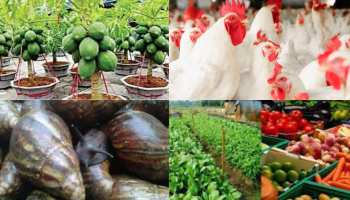Snail farming is one of the most lucrative agribusinesses in Nigeria, experts in the snail industry have argued that its is worth $12,000,000,000 with 450,000 tons consumed annually. Snail farming is a fantastic agricultural venture to take into consideration because it takes little physical labor, requires little capital, and offers significant returns on investments. Snails do not get sick quickly, unlike other animals, and can survive on domestic garbage, therefore snail farming does not require a large area of land, expensive housing, enclosures, or equipment. Achatina Achatina (Giant Tiger Snail), Achatina Fulica (East African Land Snail), and Archachatina Marginata are the three species of snails that the majority of farmers raise (giant West African snail).
Nigerian snail growers, however, favor the large African snail (Achatina Achatina). One of the largest snails in the world, the Giant African snail can produce up to 1,200 eggs per year.
This industry, also known as heliciculture, is rapidly growing in popularity in Nigeria as consumer demand rises as a result of the health advantages of snail meat and other raw materials that may be produced from snail farming, like slime, among others.

Why Snail Farming?
The market opportunity for businesses engaged in snail farming is enormous, yet it is wildly undervalued and mostly untapped. This risk-free, capital-friendly agriculture has limitless market potential in Nigeria and throughout Africa. In fact, since it can be set up in the backyard using tires or drums and fed scraps, a snail farming business might be considered a side gig.
How to start a snail farm?
Decide species of snail to farm.
African farmers prefer the Achatina achatina species because it thrives well and best in warm climate regions like Africa.
Set-up snail pens.
Depending on the size of the farm, snails can survive in a variety of containers, including baskets, old car tires, old drums, and ancient tanks. Large commercial snail farms may also use an intense housing scheme. With this approach, enclosed enclosures are constructed to simulate natural snail homes.
Nonetheless, the farmer is in total charge and keeps an eye on the snails’ daily activities, including feeding, cleaning, and hatching. Green dwellings, climate-controlled structures, and plastic tunnels are a few examples. It’s also crucial to remember that snail pens or homes ought to be roomy because congestion in the snailery will prevent snail development.
A system of evenly spaced snail housing also lowers the possibility of disease outbreak. Second, experts recommend making snail dwellings escape-proof and placing pens 45 degrees away from sunset. Because snails often produce more in a cool climate, the homes should be constructed away from harsh sunlight and freezing temperatures.

Kind of soil
Due to its high quantity of organic content, sandy-loamy soil is recommended for snail farming by experts.
Feeding
Snails are vegetarians and may eat a range of foods, including lettuce, mango, bananas, eggplant, pears, tomatoes, cassava, okra leaves, and paw-paw. But, home waste given to snails as food must be free of hairy leaves and grease.






